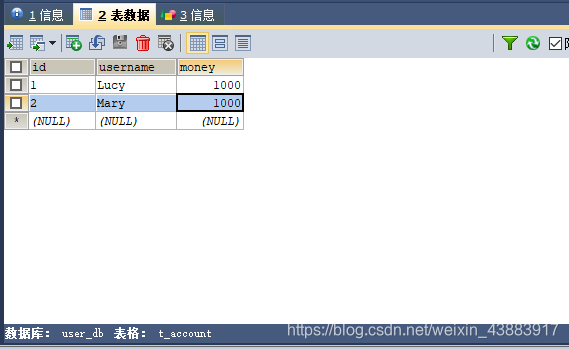目录
事务的概念
事务的概念(通俗理解):事务是数据库操作最基本单元,逻辑上一组操作,要么都成功,如果有一个失败所有操作都失败。
典型场景:银行转账(这两件事必须都成功或都不成功)
lucy 转账 100 元 给 mary
lucy 少 100,mary 多 100
事务四个特性(ACID)
(1)原子性:这个过程不可分割。
(2)一致性:操作之前和操作之后的总量不变。
(3)隔离性:多事务操作时不会相互参生影响。
(4)持久性:事务提交后数据库数据会发生变化。
搭建事务操作的环境

创建数据库表,添加记录

代码演示
(1)创建 service,搭建 dao,完成对象创建和注入关系。
(2)service 注入 dao,在 dao 注入 JdbcTemplate,在 配置文件中在JdbcTemplate 中注入 DataSource。
(3)在 dao 创建两个方法:多钱和少钱的方法,在 service 创建方法(转账的方法)。
jdbc.properties:
jdbc.driverClass=com.mysql.jdbc.Driver
jdbc.url=jdbc:mysql://127.0.0.1:3306/user_db?characterEncoding=utf8&useUnicode=true&useSSL=false
jdbc.username=root
jdbc.password=18044229
bean1.xml:
<?xml version="1.0" encoding="UTF-8"?>
<beans xmlns="http://www.springframework.org/schema/beans"
xmlns:xsi="http://www.w3.org/2001/XMLSchema-instance"
xmlns:p="http://www.springframework.org/schema/p"
xmlns:util="http://www.springframework.org/schema/util"
xmlns:tx="http://www.springframework.org/schema/tx"
xmlns:context="http://www.springframework.org/schema/context"
xsi:schemaLocation="http://www.springframework.org/schema/beans http://www.springframework.org/schema/beans/spring-beans.xsd
http://www.springframework.org/schema/util http://www.springframework.org/schema/util/spring-util.xsd
http://www.springframework.org/schema/tx http://www.springframework.org/schema/tx/spring-tx.xsd
http://www.springframework.org/schema/context http://www.springframework.org/schema/context/spring-context.xsd">
<!--开启组件扫描-->
<context:component-scan base-package="com.Keafmd"></context:component-scan>
<!--引入外部的属性文件-->
<context:property-placeholder location="classpath:jdbc.properties"/>
<!--配置连接池-->
<bean id="dataSource" class="com.alibaba.druid.pool.DruidDataSource">
<property name="driverClassName" value="${jdbc.driverClass}"></property>
<property name="url" value="${jdbc.url}" ></property>
<property name="username" value="${jdbc.username}" ></property>
<property name ="password" value="${jdbc.password}" ></property>
</bean>
<!--创建jdbcTemplate对象-->
<bean id="jdbcTemplate" class="org.springframework.jdbc.core.JdbcTemplate">
<!--注入DataSource-->
<property name="dataSource" ref="dataSource"></property>
</bean>
</beans>
UserDao 接口:
package com.Keafmd.spring5.dao;
/**
* Keafmd
*
* @ClassName: UserDao
* @Description:
* @author: 牛哄哄的柯南
* @date: 2021-01-20 10:09
*/
public interface UserDao {
//多钱
public void addMoney();
//少钱
public void reduceMoney();
}
实现类UserDaoImpl :
package com.Keafmd.spring5.dao;
import org.springframework.beans.factory.annotation.Autowired;
import org.springframework.jdbc.core.JdbcTemplate;
import org.springframework.stereotype.Repository;
import javax.sql.rowset.JdbcRowSet;
/**
* Keafmd
*
* @ClassName: UserDaoImpl
* @Description:
* @author: 牛哄哄的柯南
* @date: 2021-01-20 10:09
*/
@Repository
public class UserDaoImpl implements UserDao{
@Autowired
private JdbcTemplate jdbcTemplate;
//少钱
@Override
public void reduceMoney() {
String sql = "update t_account set money =money-? where username =?";
jdbcTemplate.update(sql,100,"Lucy");
}
//多钱
@Override
public void addMoney() {
String sql = "update t_account set money =money+? where username =?";
jdbcTemplate.update(sql,100,"Mary");
}
}
UserService 类:
package com.Keafmd.spring5.service;
import com.Keafmd.spring5.dao.UserDao;
import org.springframework.beans.factory.annotation.Autowired;
import org.springframework.stereotype.Service;
import org.springframework.transaction.annotation.Transactional;
/**
* Keafmd
*
* @ClassName: UserService
* @Description:
* @author: 牛哄哄的柯南
* @date: 2021-01-20 10:08
*/
@Service
public class UserService {
//注入dao
@Autowired
private UserDao userDao;
//转账的方法
public void accountMoney(){
// Lucy 少100
userDao.reduceMoney();
//Mary多100
userDao.addMoney();
}
}
测试类:
package com.Keafmd.spring5.test;
import com.Keafmd.spring5.config.TxConfig;
import com.Keafmd.spring5.service.UserService;
import org.junit.Test;
import org.springframework.context.ApplicationContext;
import org.springframework.context.annotation.AnnotationConfigApplicationContext;
import org.springframework.context.support.ClassPathXmlApplicationContext;
/**
* Keafmd
*
* @ClassName: TestAccount
* @Description:
* @author: 牛哄哄的柯南
* @date: 2021-01-20 10:40
*/
public class TestAccount {
@Test
public void test1(){
ApplicationContext context = new ClassPathXmlApplicationContext("bean1.xml");
UserService userService = context.getBean("userService",UserService.class);
userService.accountMoney();
}
}
测试前的数据:

测试后的数据:

这样正常执行,没有问题,但是如果中途出错了呢?接着往下看。
事务场景引入
上面代码,如果正常执行没有问题的,但是如果代码执行过程中出现异常,就会有问题,假如在Lucy少100后代码发生了错误,那么会怎样?
我们手动添加个错误:
//转账的方法
public void accountMoney(){
// Lucy 少100
userDao.reduceMoney();
//手动添加异常
int i =100/0;
//Mary多100
userDao.addMoney();
}
这样数据的变化就会出现问题。
测试前的数据:

测试后的数据:

这样就发生了问题,Lucy少了100但是Mary却没有多。这就需要利用事务来解决,让其在发生错误的时候进行回滚。
事务管理介绍
1、事务添加到 JavaEE 三层结构里面 Service 层(业务逻辑层)
2、在 Spring 进行事务管理操作
有两种方式:
(1)编程式事务管理(不方便)
(2)声明式事务管理(使用)
3、声明式事务管理
(1)基于注解方式(简单方便)
(2)基于 xml 配置文件方式
4、在 Spring 进行声明式事务管理,底层使用 AOP 原理
5、Spring 事务管理 API
提供一个接口,代表事务管理器,这个接口针对不同的框架提供不同的实现类:
Spring中使用的是DataSourceTransactionManager

注解声明式事务管理
(1)在 spring 配置文件配置事务管理器
(2)在 spring 配置文件,开启事务注解
(3)在 spring 配置文件引入名称空间 tx
(4)开启事务注解
bean1.xml:
<?xml version="1.0" encoding="UTF-8"?>
<beans xmlns="http://www.springframework.org/schema/beans"
xmlns:xsi="http://www.w3.org/2001/XMLSchema-instance"
xmlns:p="http://www.springframework.org/schema/p"
xmlns:util="http://www.springframework.org/schema/util"
xmlns:tx="http://www.springframework.org/schema/tx"
xmlns:context="http://www.springframework.org/schema/context"
xsi:schemaLocation="http://www.springframework.org/schema/beans http://www.springframework.org/schema/beans/spring-beans.xsd
http://www.springframework.org/schema/util http://www.springframework.org/schema/util/spring-util.xsd
http://www.springframework.org/schema/tx http://www.springframework.org/schema/tx/spring-tx.xsd
http://www.springframework.org/schema/context http://www.springframework.org/schema/context/spring-context.xsd">
<!--开启组件扫描-->
<context:component-scan base-package="com.Keafmd"></context:component-scan>
<!--引入外部的属性文件-->
<context:property-placeholder location="classpath:jdbc.properties"/>
<!--配置连接池-->
<bean id="dataSource" class="com.alibaba.druid.pool.DruidDataSource">
<property name="driverClassName" value="${jdbc.driverClass}"></property>
<property name="url" value="${jdbc.url}" ></property>
<property name="username" value="${jdbc.username}" ></property>
<property name ="password" value="${jdbc.password}" ></property>
</bean>
<!--创建jdbcTemplate对象-->
<bean id="jdbcTemplate" class="org.springframework.jdbc.core.JdbcTemplate">
<!--注入DataSource-->
<property name="dataSource" ref="dataSource"></property>
</bean>
<!--创建事务管理器-->
<bean id="transactionManager" class="org.springframework.jdbc.datasource.DataSourceTransactionManager">
<!--注入数据源-->
<property name="dataSource" ref="dataSource"></property>
</bean>
<!--开启事务注解-->
<tx:annotation-driven transaction-manager="transactionManager"></tx:annotation-driven>
</beans>
在 service 类上面(或者 service 类里面方法上面)添加事务注解:
(1)@Transactional,这个注解添加到类上面,也可以添加方法上面
(2)如果把这个注解添加类上面,这个类里面所有的方法都添加事务
(3)如果把这个注解添加方法上面,为这个方法添加事务
UserService 类:
package com.Keafmd.spring5.service;
import com.Keafmd.spring5.dao.UserDao;
import org.springframework.beans.factory.annotation.Autowired;
import org.springframework.stereotype.Service;
import org.springframework.transaction.annotation.Transactional;
/**
* Keafmd
*
* @ClassName: UserService
* @Description:
* @author: 牛哄哄的柯南
* @date: 2021-01-20 10:08
*/
@Service
@Transactional // @Transactional,这个注解添加到类上面
public class UserService {
//注入dao
@Autowired
private UserDao userDao;
//转账的方法
public void accountMoney(){
// Lucy 少100
userDao.reduceMoney();
//手动添加异常,事务回滚
int i =100/0;
//Mary多100
userDao.addMoney();
}
}
现在我们添加事务后带着异常运行测试类:
测试前的数据:

测试后的数据:

很明显的看到测试后的数据没有变化,是因为发生了异常,进行了事务回滚,所以数据库中的数据都没有改变。
声明式事务管理参数配置
在 service 类上面添加注解@Transactional,在这个注解里面可以配置事务相关参数:
propagation:事务传播行为
事务传播行为:多事务方法直接进行调用,这个过程中事务 是如何进行管理的。

我们在add方法加了事务,update没有加,当我们的add调用update的时候,事务会怎么处理,这个过程就叫做事务的传播行为。有事务的方法调用没事务的,还有就是都有事务并且调用这些情况发生的时候事务会怎么处理,这些过程就叫做事务的传播行为。
事务的传播行为可以由传播属性指定。Spring 定义了7种类传播行为。

结合我们的例子介绍两种最常见的:

默认的是REQUIRED:
@Transactional(propagation = Propagation.REQUIRED)相当于:@Transactional
ioslation:事务隔离级别
(1)事务有特性成为隔离性,多事务操作之间不会产生影响。不考虑隔离性产生很多问题
(2)有三个读问题:脏读、不可重复读、虚(幻)读
脏读(致命问题):一个未提交事务读取到另一个未提交事务的数据
不可重复读(现象):一个未提交事务读取到另一提交事务修改数据
虚读(现象):一个未提交事务读取到另一提交事务添加数据
不可重复读的重点是修改了数据,同样的条件 , 你读取过的数据 , 再次读取出来发现值不一样了。
幻读的重点是新增或者删除了数据 , 第 1 次和第 2 次读出来的记录数不一样。
解决:通过设置事务隔离级别,解决读问题。

设置隔离级别方式:
@Transactional(isolation = Isolation.REPEATABLE_READ),这种可重复读是mysql默认的设置方式。
timeout:超时时间
(1)事务需要在一定时间内进行提交,如果不提交进行回滚
(2)默认值是 -1 ,设置时间以秒单位进行计算
设置方式:@Transactional(timeout = 5)
readOnly:是否只读
(1)读:查询操作,写:添加修改删除操作
(2)readOnly 默认值 false,表示可以查询,可以添加修改删除操作
(3)设置 readOnly 值是 true,设置成 true 之后,只能查询
设置方式:@Transactional(readOnly = true)
rollbackFor:回滚
设置出现哪些异常进行事务回滚
设置方式:@Transactional(rollbackFor=Exception.class)
noRollbackFor:不回滚
设置出现哪些异常不进行事务回滚
设置方式:@Transactional(notRollbackFor=RunTimeException.class)
XML声明式事务管理(不常用)
在 spring 配置文件中进行配置:
第一步:配置事务管理器
第二步:配置通知
第三步:配置切入点和切面
bean2.xml:
<?xml version="1.0" encoding="UTF-8"?>
<beans xmlns="http://www.springframework.org/schema/beans"
xmlns:xsi="http://www.w3.org/2001/XMLSchema-instance"
xmlns:p="http://www.springframework.org/schema/p"
xmlns:aop="http://www.springframework.org/schema/aop"
xmlns:util="http://www.springframework.org/schema/util"
xmlns:tx="http://www.springframework.org/schema/tx"
xmlns:context="http://www.springframework.org/schema/context"
xsi:schemaLocation="http://www.springframework.org/schema/beans http://www.springframework.org/schema/beans/spring-beans.xsd
http://www.springframework.org/schema/util http://www.springframework.org/schema/util/spring-util.xsd
http://www.springframework.org/schema/aop http://www.springframework.org/schema/aop/spring-aop.xsd
http://www.springframework.org/schema/tx http://www.springframework.org/schema/tx/spring-tx.xsd
http://www.springframework.org/schema/context http://www.springframework.org/schema/context/spring-context.xsd">
<!--开启组件扫描-->
<context:component-scan base-package="com.Keafmd"></context:component-scan>
<!--引入外部的属性文件-->
<context:property-placeholder location="classpath:jdbc.properties"/>
<!--配置连接池-->
<bean id="dataSource" class="com.alibaba.druid.pool.DruidDataSource">
<property name="driverClassName" value="${jdbc.driverClass}"></property>
<property name="url" value="${jdbc.url}" ></property>
<property name="username" value="${jdbc.username}" ></property>
<property name ="password" value="${jdbc.password}" ></property>
</bean>
<!--创建jdbcTemplate对象-->
<bean id="jdbcTemplate" class="org.springframework.jdbc.core.JdbcTemplate">
<!--注入DataSource-->
<property name="dataSource" ref="dataSource"></property>
</bean>
<!--创建事务管理器-->
<bean id="transactionManager" class="org.springframework.jdbc.datasource.DataSourceTransactionManager">
<!--注入数据源-->
<property name="dataSource" ref="dataSource"></property>
</bean>
<!--2 配置通知-->
<tx:advice id="txadvice">
<!--配置事务参数-->
<tx:attributes>
<!--指定哪种规则的方法上面添加事务-->
<tx:method name="accountMoney" propagation="REQUIRED"/>
<!--<tx:method name="account*"/>-->
</tx:attributes>
</tx:advice>
<!--3 配置切入点和切面-->
<aop:config>
<!--配置切入点-->
<aop:pointcut id="pt" expression="execution(* com.Keafmd.spring5.service.UserService.*(..))"/>
<!--配置切面-->
<aop:advisor advice-ref="txadvice" pointcut-ref="pt"/>
</aop:config>
</beans>
把UserService的@Transactional注解注释掉,其它不变,新建个测试类:
package com.Keafmd.spring5.test;
import com.Keafmd.spring5.config.TxConfig;
import com.Keafmd.spring5.service.UserService;
import org.junit.Test;
import org.springframework.context.ApplicationContext;
import org.springframework.context.annotation.AnnotationConfigApplicationContext;
import org.springframework.context.support.ClassPathXmlApplicationContext;
/**
* Keafmd
*
* @ClassName: TestAccount
* @Description:
* @author: 牛哄哄的柯南
* @date: 2021-01-20 10:40
*/
public class TestAccount {
@Test
public void test2(){
ApplicationContext context = new ClassPathXmlApplicationContext("bean2.xml");
UserService userService = context.getBean("userService",UserService.class);
userService.accountMoney();
}
}
这样我们使用的是bean2.xml配置文件,那我们这就是XML声明式事务管理。
完全注解声明式事务管理
在注解声明式事务管理我们也是需要使用bean1.xml配置文件,我们也可以不使用配置文件,创建个配置类,和注解声明式事务管理相比其它类都不变。
TxConfig类:
package com.Keafmd.spring5.config;
import com.alibaba.druid.pool.DruidDataSource;
import org.springframework.context.annotation.Bean;
import org.springframework.context.annotation.ComponentScan;
import org.springframework.context.annotation.Configuration;
import org.springframework.jdbc.core.JdbcTemplate;
import org.springframework.jdbc.datasource.DataSourceTransactionManager;
import org.springframework.transaction.annotation.EnableTransactionManagement;
import javax.sql.DataSource;
/**
* Keafmd
*
* @ClassName: TxConfig
* @Description: 完全注解开发
* @author: 牛哄哄的柯南
* @date: 2021-01-20 21:16
*/
@Configuration //配置类
@ComponentScan(basePackages = "com.Keafmd") //组件扫描
@EnableTransactionManagement // 开启事务
public class TxConfig {
//创建数据库连接池
@Bean
public DruidDataSource getDruidDataSource(){
DruidDataSource dataSource = new DruidDataSource();
dataSource.setDriverClassName("com.mysql.jdbc.Driver");
dataSource.setUrl("jdbc:mysql://127.0.0.1:3306/user_db?characterEncoding=utf8&useUnicode=true&useSSL=false");
dataSource.setUsername("root");
dataSource.setPassword("18044229");
return dataSource;
}
//创建jdbcTemplate对象
@Bean
public JdbcTemplate getJdbcTemplate(DataSource dataSource){
JdbcTemplate jdbcTemplate = new JdbcTemplate();
jdbcTemplate.setDataSource(dataSource);
return jdbcTemplate;
}
//创建事务管理器
@Bean
public DataSourceTransactionManager getDataSourceTransactionManager(DataSource dataSource){
DataSourceTransactionManager transactionManager = new DataSourceTransactionManager();
transactionManager.setDataSource(dataSource);
return transactionManager;
}
}
测试类:
package com.Keafmd.spring5.test;
import com.Keafmd.spring5.config.TxConfig;
import com.Keafmd.spring5.service.UserService;
import org.junit.Test;
import org.springframework.context.ApplicationContext;
import org.springframework.context.annotation.AnnotationConfigApplicationContext;
import org.springframework.context.support.ClassPathXmlApplicationContext;
/**
* Keafmd
*
* @ClassName: TestAccount
* @Description:
* @author: 牛哄哄的柯南
* @date: 2021-01-20 10:40
*/
public class TestAccount {
//使用配置类
@Test
public void test3(){
ApplicationContext context = new AnnotationConfigApplicationContext(TxConfig.class);
UserService userService = context.getBean("userService",UserService.class);
userService.accountMoney();
}
}
这样我们就实现了完全注解声明式事务管理。


